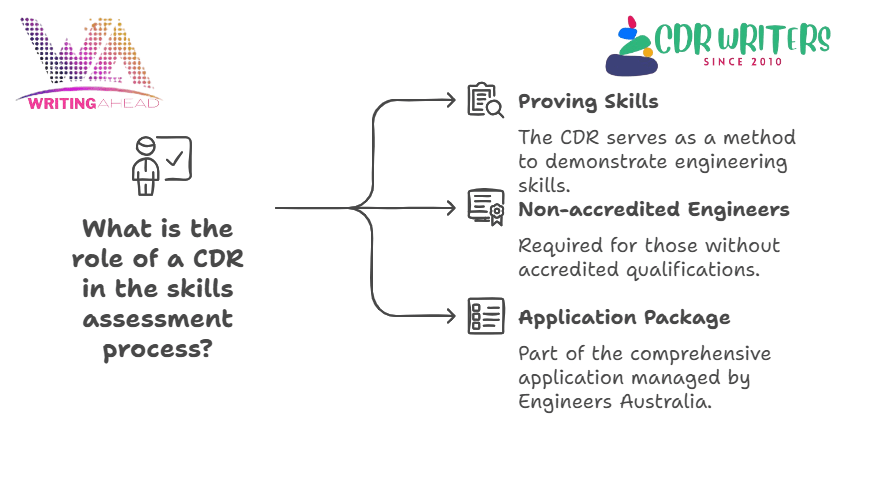Learn what the CDR pathway for Engineers Australia is, who needs it, and how international engineers can use it to get recognized and work in Australia.
CDR stands for Competency Demonstration Report. It is a formal document required by Engineers Australia (EA) to assess the qualifications, skills, and experience of engineers with overseas qualifications.
It is part of the Migration Skills Assessment (MSA) process, essential for international engineers who want to:
-
Work in Australia
-
Apply for Skilled Migration Visas like Subclass 189, 190, or 491
-
Get professionally recognized in the Australian workforce
Why Engineers Australia Requires the CDR Pathway
Engineers Australia follows international benchmarking standards. However, not all engineering qualifications are directly recognized.
If your degree isn’t accredited under the:
-
Washington Accord (Professional Engineers)
-
Sydney Accord (Engineering Technologists)
-
Dublin Accord (Engineering Associates)
…then the CDR is the only acceptable method to prove your competency.
This ensures that all practicing engineers in Australia have the skills, knowledge, and ethics to operate safely and effectively.
Who Needs to Follow the CDR Pathway?
You are required to go through the CDR process if:
-
Your engineering qualification is from a non-accredited university or country
-
Your degree is not listed under any international accord
-
You are applying under any ANZSCO engineering code without an eligible qualification
Countries typically requiring CDR include India, Pakistan, Bangladesh, Iran, Egypt, Philippines, and others with non-Accord qualifications.
Components of the CDR Report
Your CDR submission must include three key documents:
| Document | Purpose |
|---|---|
| CPD Statement | Proves ongoing learning since graduation |
| Career Episodes (3) | Real-life project stories that demonstrate your competencies |
| Summary Statement | Maps each competency element to the relevant episode |
Each part must be original, clear, and technically sound—and must reflect your personal engineering contributions.
Step-by-Step Guide to Submitting a CDR
🧭 Step 1: Choose Your ANZSCO Code
Select the code that best matches your job title and experience (e.g., 233211 – Civil Engineer).
🛠️ Step 2: Prepare the CDR Components
-
Write three Career Episodes focused on your technical projects
-
Complete your CPD log
-
Fill out the Summary Statement referencing the EA competencies
📤 Step 3: Submit via EA’s Online Portal
-
Register and log in to the Engineers Australia portal
-
Upload all your documents
-
Pay the required assessment fee
Engineers Australia Competency Elements
Your CDR is assessed against 16 competency elements, grouped under:
-
PE1: Knowledge and Skill Base
-
PE2: Engineering Application Ability
-
PE3: Professional and Personal Attributes
You must map each element to specific paragraphs in your Career Episodes using the Summary Statement.
How Engineers Are Assessed Through the CDR
Engineers Australia wants to see that you:
-
Understand technical concepts
-
Apply problem-solving and design techniques
-
Work ethically and communicate professionally
-
Can demonstrate individual leadership and responsibility
They assess whether you’re ready to operate in the Australian engineering environment—independently and safely.
Common Mistakes in the CDR Pathway
❌ 1. Copying from Online Samples
EA uses plagiarism software. Copied content leads to rejection or a ban.
❌ 2. Writing About Team Efforts
Focus must be on what you did, not what the team achieved.
❌ 3. Ignoring Technical Depth
Use real numbers, tools, methods, and outcomes to showcase technical knowledge.
Benefits of Choosing the CDR Pathway
✅ Flexibility
Showcase a wide range of experience, even from different industries or countries.
✅ Control
You decide which projects to highlight and how to present your strengths.
✅ Accessibility
Anyone with real engineering experience can apply—no additional academic study needed.
FAQs About the CDR Pathway
1. Is CDR only for migration purposes?
Primarily, yes. It’s part of the Migration Skills Assessment (MSA) required for PR.
2. Can I use academic projects in Career Episodes?
Yes, but professional work experience is preferred.
3. Is there an interview involved?
Usually not—unless further clarification is needed.
4. How long does CDR assessment take?
Typically 8–12 weeks, or faster with priority processing.
5. Can I write in any language?
No. Your CDR must be in English, even if your original documents are not.
6. Can I reapply if rejected?
Yes. EA provides feedback, and you can resubmit after corrections.
Conclusion: Your Gateway to Engineering Recognition in Australia
The CDR pathway is the most comprehensive and accessible route for international engineers to become professionally recognized in Australia.
If your qualifications don’t meet automatic recognition standards, CDR is your bridge to a fulfilling engineering career down under. With careful preparation, honesty, and technical clarity, you can successfully earn Engineers Australia’s approval—and open doors to permanent residency, job opportunities, and professional respect.











































